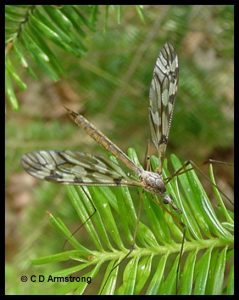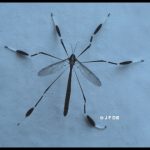Crane Flies

Crane flies are rather large flies with slender bodies and long, fragile legs that break off easily. Although similar in appearance to a giant mosquito, they are not a kind of mosquito at all and do not bite, even though some people know them–incorrectly–by the name of “mosquito hawks,” which is a term that actually refers to dragonflies because of the large numbers of mosquitoes that dragonflies consume. However, adult crane flies are not known to feed on anything and are medically harmless. Like most flies, adult crane flies are attracted to lights at night and can be a real nuisance when they end up indoors, flying around awkwardly, weakly, and bumping into things. Most species of crane flies are referred to as “Large Crane Flies” in the family Tipulidae. However, there is another group of crane flies called “Phantom Crane Flies” that belong to their own family called Ptychopteridae.

Crane fly larvae are legless, grey-brown in color, worm-like in overall shape but with some small finger-like projections visible on the tip of the posterior end. They have rather tough and leathery skin so are often referred to as “leatherjackets.” Most species of them feed primarily on decomposing organic matter, especially in either wet or very moist environments, but some species feed on the roots of grasses and can give rise to bare/brown patches in residential lawns akin to those that are caused by the “white grubs” of various species of scarab beetles. With most species there is but one generation per year, with mating and egg-laying (in the soil) occurring during the summer months with larvae feeding in the fall and spring. Crane fly larvae are dormant during the winter, and emerge as adults from their pupal cases by the time summer arrives.
There are more than 1,600 species of crane flies in North America. The vast majority of crane flies are considered nothing more than an occasional nuisance. There are a few species, however, that feed on grass roots. These include the marsh crane fly (Tipula oleracea) and the European crane fly (Tipula paludosa). Both of these crane flies are invasive species (native to Europe and northern Africa) which are now widespread across much of North America. The marsh crane fly has multiple generations each year, while the common European crane fly has only one generation a year.
- Crane Fly Larvae (often called “leatherjackets” due to their tough skin)
- Crane Fly Larvae
- Phantom Crane Fly (Family Ptychopteridae)
Additional Information:
- Crane Flies (University of Arizona)
- Crane Flies (Texas A&M)
- European Crane Fly / Leatherjacket (invasive) (Tipula paludosa) (pest of lawns and turf) (Cornell)
- Managing Crane Fly in Lawns (Oregon State University Extension Service)
- Crane Fly Larvae in Turf (NC State)



